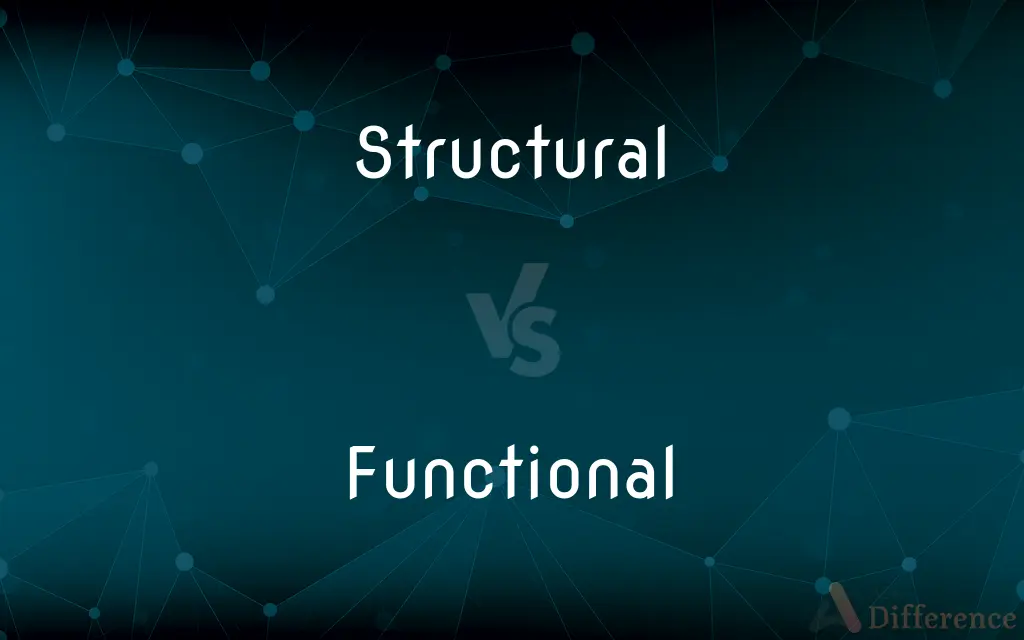Structural vs. Functional — What's the Difference?
By Tayyaba Rehman & Urooj Arif — Updated on March 15, 2024
Structural pertains to the physical makeup, whereas functional relates to the purpose or activity.

Difference Between Structural and Functional
Table of Contents
ADVERTISEMENT
Key Differences
Structural aspects concern the physical composition and architecture of entities, defining their shape, size, and construction. These characteristics are essential in understanding the stability, durability, and physical capabilities of a structure, whether it's an anatomical feature, a building, or any physical system. Functional aspects, on the other hand, focus on the operation, role, and activities associated with an entity. This perspective is crucial for understanding how something works, its purpose, and its effectiveness in performing designated tasks or roles.
While structural attributes provide the foundation and potential for an entity's capabilities, functional attributes bring that potential to life, demonstrating how structural characteristics are harnessed to perform specific tasks or functions.
In many fields, especially in biology and engineering, the relationship between structure and function is a fundamental concept, highlighting that the way something is built (structure) often directly influences how it operates (function). This interplay is evident in biological organisms, where the structure of an organ determines its function, and in architecture, where the design of a building influences its usability and purpose.
The distinction between structural and functional can guide the approach to problem-solving and analysis. Structural analysis might focus on the material integrity, design, or construction flaws, while functional analysis might look at process inefficiencies, operational failures, or effectiveness in fulfilling intended roles.
Comparison Chart
Definition
Pertains to the physical makeup and architecture
Relates to the purpose, operation, and activity
ADVERTISEMENT
Focus
Composition, shape, and construction
Operation, role, and effectiveness
Importance
Provides foundation and potential capabilities
Demonstrates actual performance and purpose
Relationship
Often determines potential functionality
Dependent on structural integrity for operation
Analysis Approach
Examines material integrity, design, construction
Evaluates process efficiency, operational roles
Compare with Definitions
Structural
Structural attributes define the physical framework and organization.
The structural integrity of a bridge ensures its ability to bear loads.
Functional
Functional attributes describe how something operates or serves a purpose.
The functional role of the heart is to pump blood throughout the body.
Structural
Structural aspects are foundational to the functionality of an entity.
The structural composition of a bone supports the body's mobility.
Functional
They emphasize the activities, roles, and effectiveness of an entity.
The functionality of software is judged by its ease of use and performance.
Structural
They focus on materials, design, and construction techniques.
Structural engineers assess materials for their strength and durability.
Functional
Functional analysis assesses operational efficiency and role fulfillment.
Evaluating the functionality of an ecosystem involves studying species interactions.
Structural
Structural characteristics are essential for stability and durability.
The structural design of a building dictates its resistance to natural disasters.
Functional
The functionality often adapts within the limits set by structural properties.
Functional adaptations in animals often reflect their structural characteristics.
Structural
The analysis of structural features helps identify potential physical limitations.
Structural analysis can reveal vulnerabilities in an aging infrastructure.
Functional
Functional aspects focus on the dynamic performance and utility of an entity.
The functional design of a kitchen prioritizes workflow and accessibility.
Structural
Of, relating to, having, or characterized by structure
Structural simplicity.
Functional
Of or relating to a function.
Structural
Affecting structure
Structural damage.
Functional
Of, relating to, or indicating a mathematical function or functions.
Structural
Used in or necessary to building
Structural beams.
Functional
Designed for or adapted to a particular function or use
Functional architecture.
Structural
Concerned with or resulting from political or especially economic structure.
Functional
Capable of performing a function; operative
A functional set of brakes.
Structural
(Geology) Of or relating to the structure of rocks and other aspects of the earth's crust.
Functional
Able to function personally or socially despite limitations or impairment
A functional alcoholic.
Structural
(Biology) Of or relating to organic structure; morphological.
Functional
(Medicine) Involving physiological function rather than anatomical structure.
Structural
Relating to or concerned with systematic structure in a particular field of study, such as linguistics or the behavioral sciences.
Functional
A linear function on vectors whose values are scalars.
Structural
A part of a structure that bears a weight, or the structural piece used for such a part.
Functional
In good working order.
Structural
Of, relating to, or having structure.
Functional
Useful; serving a purpose, fulfilling a function
That sculpture is not merely artistic, but also functional: it can be used as a hatrack.
Structural
Involving the mechanics of construction.
Functional
Only for functional purposes, notably in architecture
A functional construction element generally must meet higher technical but lower aesthetical requirements
Structural
That is lasting. economics
Functional
(computing theory) Having semantics defined purely in terms of mathematical functions, without side-effects.
Structural
Structural steel, used in construction.
Functional
(medicine) Of a disease, such that its symptoms cannot be referred to any appreciable lesion or change of structure; opposed to organic disease, in which the organ itself is affected.
Structural
Of or pertaining to structure; affecting structure; as, a structural error.
Functional
(mathematics) A function that takes a function as its argument; More precisely: A function whose argument varies in a space of (real or complex valued) functions and whose value belongs to a monodimensional space. An example is the definite integration of integrable real functions in a real interval.
Structural
Of or pertaining to organit structure; as, a structural element or cell; the structural peculiarities of an animal or a plant.
Functional
A scalar-valued linear function on a vector space.
Structural
Relating to or caused by structure, especially political or economic structure;
Structural unemployment in a technological society
Functional
(computing) An object encapsulating a function pointer (or equivalent).
Structural
Relating to or having or characterized by structure;
Structural engineer
Structural errors
Structural simplicity
Functional
Pertaining to, or connected with, a function or duty; official.
Structural
Affecting or involved in structure or construction;
The structural details of a house such as beams and joists and rafters; not ornamental elements
Structural damage
Functional
Pertaining to the function of an organ or part, or to the functions in general; involving or affecting function rather than physiology; as, functional deafness; a functional disease. See functional disease, below.
Structural
Concerned with systematic structure in a particular field of study
Functional
Designed for or capable of a particular function or use; as, a style of writing in which every word is functional; functional architecture.
Structural
Pertaining to geological structure;
Geomorphological features of the Black Hills
Morphological features of granite
Structural effects of folding and faulting of the earth's surface
Functional
Fit or ready for use or service; useable; in working order; as, the toaster was still functional even after being dropped; the lawnmower is a bit rusty but still functional. Antonym of out of order and nonfunctional.
Structural
Relating to or concerned with the morphology of plants and animals;
Morphological differences
Functional
Designed to emphasize practical utility rather than artistic or aesthetic purposes; as, functional education selects knowledge that is concrete and usable rather than abstract and theoretical; functional architecture; an amateurish device, crude but functional.
Functional
Designed for or capable of a particular function or use;
A style of writing in which every word is functional
Functional architecture
Functional
Involving or affecting function rather than physiology;
Functional deafness
Functional
Relating to or based on function especially as opposed to structure;
The problem now is not a constitutional one; it is a functional one
Delegates elected on a functional rather than a geographical basis
Functional
Fit or ready for use or service;
The toaster was still functional even after being dropped
The lawnmower is a bit rusty but still usable
An operational aircraft
The dishwasher is now in working order
Functional
Designed for or adapted to a function or use;
Functional education selects knowledge that is concrete and usable rather than abstract and theoretical
Functional architecture
Functional
(of e.g. a machine) performing or capable of performing;
In running (or working) order
A functional set of brakes
Common Curiosities
Is the study of structure and function important in all fields?
While particularly crucial in biology, engineering, and architecture, this study is relevant in any field where physical form impacts function.
Are functional attributes independent of structural ones?
Functional attributes are often dependent on structural integrity but can adapt within structural constraints.
How do structural changes affect functionality?
Structural changes can enhance or impair functionality, depending on whether they align with or obstruct the intended purpose.
In what ways can functional demands lead to structural adaptations?
Functional demands can drive structural adaptations through evolution, innovation, or design modifications to meet new or changing requirements.
How do structural and functional analyses complement each other in diagnostics?
Structural analysis identifies physical anomalies, while functional analysis assesses performance, together providing a comprehensive diagnostic overview.
How do structural and functional aspects relate to each other?
Structural attributes provide the physical foundation, influencing and enabling functional capabilities.
Can something have structural integrity but be functionally obsolete?
Yes, an entity can be structurally sound but may no longer serve a relevant or efficient function.
Are there instances where structure and function are not directly related?
In some complex systems, the relationship might be indirect or obscured by multifunctionality and redundancy.
In what ways can the study of structure and function aid in sustainability efforts?
Analyzing structure and function can lead to more efficient designs and operations, reducing resource use and environmental impact in various fields.
How can understanding structure help in improving function?
Understanding structure allows for targeted modifications to enhance or expand functionality by optimizing physical attributes.
Can a functional analysis reveal structural flaws?
Yes, functional inefficiencies or failures often indicate underlying structural issues that need addressing.
Why is the structure-function relationship particularly important in biology?
In biology, the structure-function relationship is vital as it explains how physiological features support the life processes of organisms.
How does architecture exemplify the structure-function relationship?
Architecture exemplifies this relationship through the design of buildings and spaces that aesthetically and physically support intended uses.
How do technological advancements impact the structure-function paradigm?
Technological advancements can redefine possibilities, allowing for new functions within existing structures or the creation of novel structures for advanced functions.
Can functional requirements influence structural design in engineering?
Yes, functional requirements often dictate structural design in engineering to ensure that constructions meet operational needs.
Share Your Discovery

Previous Comparison
Fission vs. Fragmentation
Next Comparison
GATT vs. WTOAuthor Spotlight
Written by
Tayyaba RehmanTayyaba Rehman is a distinguished writer, currently serving as a primary contributor to askdifference.com. As a researcher in semantics and etymology, Tayyaba's passion for the complexity of languages and their distinctions has found a perfect home on the platform. Tayyaba delves into the intricacies of language, distinguishing between commonly confused words and phrases, thereby providing clarity for readers worldwide.
Co-written by
Urooj ArifUrooj is a skilled content writer at Ask Difference, known for her exceptional ability to simplify complex topics into engaging and informative content. With a passion for research and a flair for clear, concise writing, she consistently delivers articles that resonate with our diverse audience.
















































